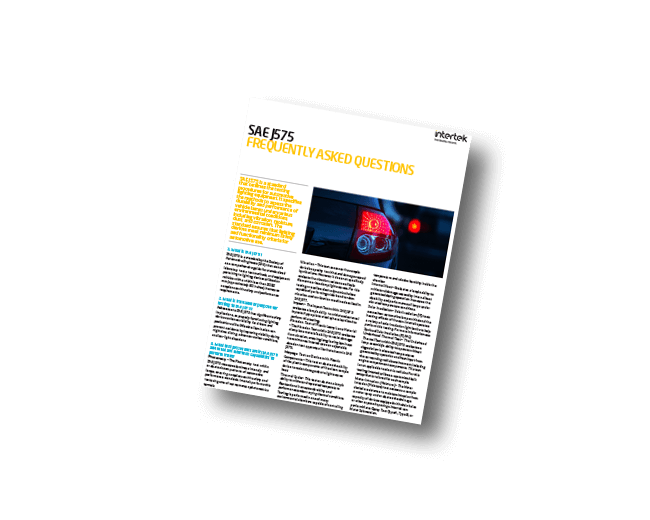Speed ahead in the market with comprehensive Automotive Lighting, Headlamp and Photometric Testing solutions
Automotive Lighting Testing is the process of evaluating the performance of lighting systems used in vehicles, including headlights, taillights, turn signals, and other types of lighting. The testing is typically conducted to ensure that the lighting meets regulatory and safety standards, as well as to evaluate the quality and effectiveness of the lighting for visibility and aesthetics.
Automotive lighting testing can include a variety of measurements and assessments, including:
- Photometric testing - This involves measuring the intensity, distribution, and direction of light emitted from a lighting system.
- Durability testing - This involves subjecting lighting systems to various environmental and mechanical stresses to evaluate their ability to withstand wear and tear.
- Electrical testing - This involves testing the electrical components of lighting systems, such as voltage, current, and resistance.
- Environmental testing - This involves exposing lighting systems to various environmental conditions, such as temperature, humidity, and vibration, to evaluate their performance under different operating conditions.
- Safety testing - This involves evaluating the safety features of lighting systems, such as their ability to alert other drivers of the presence of a vehicle and to provide adequate lighting for safe driving.
FMVSS 108: Standard for Automotive Lighting & Reflective Device Testing
FMVSS 108 is a set of Federal Motor Vehicle Safety Standards established by the National Highway Traffic Safety Administration (NHTSA) in the United States. These standards set out the requirements for lighting and reflectors used in motor vehicles, including passenger cars, trucks, buses, and trailers.
FMVSS 108 specifies the minimum performance requirements for lighting and reflectors to ensure that vehicles are visible to other drivers and pedestrians on the road, and to provide adequate illumination for safe driving at night. Learn more about FMVSS 108.
Intertek’s Automotive Lighting and Photometric Testing capabilities include:
Intertek is accredited by VCA (Vehicle Certification Agency), A2LA and AMECA to test automotive lighting, including headlamps, tail lamps, turn signals, reflectors, center high-mount stop lights (CHMSLs), warning lights, interior lighting and other products, to industry and OEM standards, including FMVSS, CMVSS, SAE, and JIS. We also test lighting for ATVs, agricultural equipment, snowmobiles, motorcycles and construction/industrial machinery.
Adaptive Beam Headlights
VCA (Vehicle Certification Agency) Scope of Accreditation
UNECE (United Nations Economic Commission for Europe) Vehicle
- Reg. 1 - Headlamps, Asymmetrical Beam w/ R2 filaments
- Reg. 2 - Incandescent Lamps
- Reg. 3 - Retroflecting Devices
- Reg. 4 - Registration Plate Lamps
- Reg. 5 - Sealed Beam Headlamps
- Reg. 6 - Direction Indicators
- Reg. 7 - Front/Rear Position Lamps, Stop Lamps, End Outline Marker Lamps
- Reg. 8 - Headlamps, Asymmetrical Beam w/ H1, H2, H3, HB3, HB4, H7, H8, H9, H1R1, H1R2 and/or H11
- Reg. 19 - Front Fog Lamps
- Reg. 20 - Headlamps, Asymmetrical Beam w/ H4
- Reg. 23 - Reversing Lamps
- Reg. 31 - Headlamps, Asymmetrical Halogen Sealed Beam
- Reg. 37 - Filament Lamps
- Reg. 38 - Rear Fog Lamps
- Reg. 50 - Moped and Motorcycle Signaling and Marking Devices
- Reg. 56 / 76 / 82 - Moped Headlamps
- Reg. 57 / 72 - Motorcycle Headlamps
- Reg. 65 - Special Warning Lights
- Reg. 69 - Rear Marking Plates for Slow-Moving Vehicles
- Reg. 70 - Rear Marking Plates for Heavy and Long Vehicles
- Reg. 77 - Parking Lamps
- Reg. 87 - Daytime Running Lamps
- Reg. 91 - Sidemarker Lamps
- Reg. 98 - Headlamps, Gas Discharge Light Source
- Reg. 104 - Retroreflection, Heavy and Long Vehicles
- Reg. 112 - Headlamps, Filament Lamps, Asymmetrical
- Reg. 113 - Headlamps, Filament Lamps, Asymmetrical
- Reg. 119 - Cornering Lamps
A2LA (American Association for Laboratory Accreditation) Scope of Accreditation
- www.a2la.org, certificate #78.02
- Federal Motor Vehicle Safety Standard 108 (FMVSS 108)
- Forward Lighting Devices
- Signaling, Marking and Rear Lighting Devices
- Spectrophotometry (SAE J578)
- Photometry of Retroreflective Materials
- Agricultural Machinery
- All-Terrain Vehicles
- Snowmobiles
- Warning Lamps and Devices
- Construction and Industrial Machinery
- Motorcycles
- Strobe Lamps
AMECA (Automotive Manufacturer Equipment Compliance Agency) Scope Accreditation
- www.ameca.org
- Headlamps - Replaceable Bulb & Sealed Beam, Aiming Equipment
- Backup Lamps
- Center High Mounted Stop Lamp
- Clearance / Identification / Sidemarker Lamps
- Cornering and Parking Lamps
- License Plate Lamps
- Reflex Reflectors (automobiles, motorcycles, bicycles, pedals, and tires)
- Stoplamps / Taillamps / Turn Signal Lamps
- Auxiliary Low Beam Lamps
- Driving Lamps
- Fog Lamps
- Spot Lamps
- High Mounted Stop Lamp (HMSL)
- School Bus Alternating Warning Lamps, Stop Arm & Roof Mounted Warning Lamps
- Motorcycle Headlamp Assembly, Turn Signal Lamps and Auxiliary Front Lamps
Automotive Mirrors Testing
Products tested include: Flat mirrors and convex mirrors. Test capabilities include:
- Reflectance
- Radius of Curvature
- Unit of Magnification
- Corrosion, Humidity & Temperature
- Vibration
Specifications Commonly Tested Include:
- FMVSS 111
- SAE J964
- ECE Reg. 46
- OEM & Proprietary Specifications
EMC Testing
- AEMCLAP Accredited; Ford & GM Approved
- GMW3097
- Ford ES-XW-7T-1A278-AC
- SAE J1113
- ISO 11452
Other Equipment Capabilities
- GMN8020TP HALT and Intermittence Detection
- Dust Chamber per SAE J575e (1970)
- Moisture Chamber per SAE J575e (1970)
- Vibration Table per SAE J577 (1958)
- Marine Lamp Testing (ABYC)
- MIL-STD-1179D (Lamps, Reflectors, and associated Signaling Equipment for Military Vehicles)
- Photometric Testing
- Color Testing
- Blackout Visibility Testing
- Random and Sine Vibration
- Compliance Consulting
- Fixture Design and Fabrication
- ROMER Portable CMM for coordinate measuring
In addition to testing lighting/photometrics to the FMVSS 108 standard, Intertek is a single-source provider for additional performance testing needs, including EMC (AEMCLAP Accredited, Ford & GM Approved) vibration, moisture, dust and HALT testing (Highly Accelerated Life Testing).
A broad selection of industry-recognized tests help you verify performance claims



